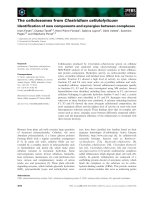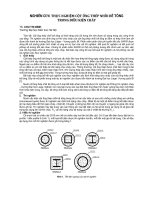Báo cáo khoa học: "Hyperoxic acute lung injury and ventilator-induced/associated lung injury: new insights into intracellular signaling pathways" docx
Bạn đang xem bản rút gọn của tài liệu. Xem và tải ngay bản đầy đủ của tài liệu tại đây (36.45 KB, 2 trang )
Page 1 of 2
(page number not for citation purposes)
Available online />Abstract
In patients with acute respiratory distress syndrome (ARDS),
supportive therapy with mechanical ventilation and oxygen is often
life saving. Further acute lung injury however, is an unfortunate
consequence of oxygen therapy as well as mechanical injury
secondary to ventilator induced/associated lung injury (VI/ALI). In
this issue of Critical Care, Li et al. expand on the intra-cellular
signaling pathways regulating interactions between injury
cascades resulting from hyperoxia and high tidal volume ventilation.
The findings, suggest that interference or cooperation of different
signals may have critical consequences as evidenced by indices of
increased lung inflammation, microvascular permeability, and lung
epithelial apoptotic cell death.
Every patient with acute respiratory distress syndrome
(ARDS) is hypoxemic by definition. In these patients,
mechanical ventilation (MV) is often life-saving. Repetitive
cyclic stretch however, results in regional overdistension
or/and derecruitment which is associated with a number of
severe complications termed ventilator-induced/associated
lung injury (VI/ALI) [1]. The attributable mortality of VI/ALI has
been estimated to be at least 9% [2], and despite evidence
that high concentrations of oxygen (fractional inhaled
concentrations of oxygen [FiO
2
] greater than 50%), can lead
to hyperoxic acute lung injury (HALI), oxygen therapy remains
a cornerstone of management. Little is known about
“permissive hypoxemia” and for the most part, clinicians will
optimize positive end expiratory pressure (PEEP) to enable
reductions in FiO
2
, accepting oxygen saturations in the mid to
high 80’s. In the first three ICU days, most ARDS patients are
ventilated with average FiO2 > 59% (mean FiO2 delivered on
day 1 = 70%) [3], but it is not uncommon for the most
severely ill to require much higher FiO
2
concentrations
(100%) for prolonged periods or frequent intervals.
In a previous issue of Critical Care, Li and colleagues
elucidate the potential mechanisms regulating interactions
between injury cascades resulting from hyperoxia and high
tidal volume ventilation [4]. Using gene-deficient models and
specific inhibitors of intracellular signaling pathways, this
author group demonstrate that the combination of hyperoxia
and high tidal volume ventilation results in augmented lung
injury, evidenced by indices of increased lung inflammation,
microvascular permeability, and lung epithelial apoptotic cell
death. The combined detrimental effect of oxygen and
repetitive cyclic stretch was shown to result in the activation
of specific intracellular signaling pathways. The paper by Li
and colleagues is part of a growing body of literature
suggesting that the response of the mechanically ventilated
lung to biochemical or biomolecular stimuli is profoundly
altered by the coexistence of injurious stimuli [5,6] that
synergize at the cellular level [7] as well as at the tissue level
[8]. More importantly, the findings suggest that interference
or cooperation of signals may have critical physiological
consequences such as activation of death pathways.
Studies on various model systems have shown that a
relatively small number of transcription factors can set up
strikingly complex spatial and temporal patterns of gene
expression. This pattern creation is achieved mainly by means
of combinatorial or differential gene regulation; that is,
regulation of a gene by two or more transcription factors
simultaneously or under different conditions. Li and
colleagues offer insight into the specific molecular details of
the mechanisms of combinatorial regulation of hyperoxia and
high tidal volume. In their model, mitogen-activated protein
kinase ERK1/2, c-Jun NH
2
-terminal kinases, and downstream
binding of the transcription factor AP-1 were responsible for
Commentary
Hyperoxic acute lung injury and ventilator-induced/associated
lung injury: new insights into intracellular signaling pathways
Claudia C Dos Santos
2
Saint Michael’s Hospital, Department of Critical Care Medicine 30, Bond Street 4-008, Toronto, ON M5G 1W8, Canada
Corresponding author: C C dos Santos,
Published: 19 April 2007 Critical Care 2007, 11:126 (doi:10.1186/cc5733)
This article is online at />© 2007 BioMed Central Ltd
See related research by Li et al., />FiO
2
= fractional inhaled concentration of oxygen; HALI = hyperoxic acute lung injury; IL = interleukin; NF = nuclear factor; TNF = tumor necrosis
factor; VI/ALI = ventilator-induced/associated lung injury.
Page 2 of 2
(page number not for citation purposes)
Critical Care Vol 11 No 2 Dos Santos
orchestrating the molecular response and cellular
physiological consequence of HALI plus VI/ALI – whilst lung
stretch alone is dependent on activation of the JNK pathway,
high volume plus hyperoxia mediated its detrimental effect via
JNK and ERK 1/2 activation.
Despite a historical emphasis on NF-κB-dependent inflam-
mation-related genes as mediators of injury, Li and
colleagues’ paper suggests that the augmented response
seen when high volume and hyperoxia coexist appears to be
NF-κB independent. The molecular implication from their
paper is that individual stimuli exert intracellular effects via
independent signaling pathways that may converge or
diverge at specific molecular ‘nodes’ or ‘hubs’ – critical
control points and potential targets for therapy. Moreover,
molecules that were previously perceived as reflecting
redundancy in the response represent a sophisticated system
that probably depends on the ‘message’ carried rather than
the messenger. The clinical implications of deciphering injury
specific intra-cellular signaling is that it provides novel insight
into the potential for future molecular treatment of injury-
specific stimuli.
Exposure to hyperoxia is a well-established model of lung
injury characterized by the development of pulmonary edema
and inflammation. The development of hyperoxic lung injury
was until recently thought to require the generation of
reactive oxygen species, which leads to alveolar epithelial and
endothelial cell death by both apoptosis and necrosis [6].
Disturbance of cell-death pathways, either local (pulmonary)
or distal (kidney and intestines), has also been implicated in
the pathogenesis of VI/ALI and ensuing MOF [9], and this
disturbance is a key feature of the alveolar remodeling
process during recovery from injury. In contrast to the
literature on VI/ALI, where increased expression of cytokines
and chemokines has been thought to be related to increase
epithelial cell apoptosis [10], in studies of HALI,
overexpression of cytokines or chemokines (for example,
TNF-α, IL-1β, IL-6, CXC-chemokine receptor 2, and IL-11),
growth factors (for example, insulin growth factor and
keratinocyte growth factor [KGF]), or the β subunit of the
Na,K-ATPase have been shown to protect animals from
hyperoxia by attenuating death signals [11]. Moreover, this
effect appears to be independent of potential antioxidant
effects, since antioxidants by themselves do not reverse or
prevent all of the manifestations of HALI and since the ability
of certain cytokines to inhibit hyperoxia-induced cell death is
independent of major alterations in lung antioxidants [12].
This evidence raises crucial questions about how different
injury signal components are integrated; what are the
morbidity and mortality defining manifestations of VI/ALI
and/or HALI and which, where and when should “outcome-
defining” pathways be blocked.
Competing interests
The author declares that they have no competing interests.
References
1. dos Santos CC, Slutsky AS: The contribution of biophysical
lung injury to the development of biotrauma. Annu Rev Physiol
2006, 68:585-618.
2. Acute Respiratory Distress Syndrome Network: Ventilation with
lower tidal volumes as compared with traditional tidal
volumes for acute lung injury and the acute respiratory dis-
tress syndrome. N Engl J Med 2000, 342:1301-1308.
3. Esteban A, Anzueto A, Frutos F, Alia I, Brochard L, Stewart TE,
Benito S, Epstein SK, Apezteguia C, Nightingale P, et al.: Charac-
teristics and outcomes in adult patients receiving mechanical
ventilation: a 28-day international study. JAMA 2002, 287:345-
355.
4. Li LF, Liao SK, Ko YS, Lee CH, Quinn DA: Hyperoxia increases
ventilator-induced lung injury via mitogen activated protein
kinases – a prospective, controlled animal experiment. Crit
Care 2007, 11:R25.
5. Tremblay L, Valenza F, Ribeiro SP, Li J, Slutsky AS: Injurious ven-
tilatory strategies increase cytokines and c-fos m-RNA
expression in an isolated rat lung model. J Clin Invest 1997,
99:944-952.
6. Altemeier WA, Sinclair SE: Hyperoxia in the intensive care unit:
why more is not always better. Curr Opin Crit Care 2007, 13:
73-78.
7. dos Santos CC, Han B, Andrade CF, Bai X, Uhlig S, Hubmayr R,
Tsang M, Lodyga M, Keshavjee, Slutsky AS, et al.: DNA microar-
ray analysis of gene expression in alveolar epithelial cells in
response to TNF
αα
, LPS, and cyclic stretch. Physiol Genom
2004, 19:331-342.
8. Altemeier WA, Matute-Bello G, Frevert CW, Kawata Y, Kajikawa
O, Martin TR, Glenny RW: Mechanical ventilation with moder-
ate tidal volumes synergistically increases lung cytokine
response to systemic endotoxin. Am J Physiol Lung Cell Mol
Physiol 2004, 287:L533-L542.
9. Imai Y, Parodo J, Kajikawa O, de Perrot M, Fischer S, Edwards V,
Cutz E, Liu M, Keshavjee S, Martin TR, et al.: Injurious mechani-
cal ventilation and end-organ epithelial cell apoptosis and
organ dysfunction in an experimental model of acute respira-
tory distress syndrome. JAMA 2003, 289:2104-2112.
10. Matute-Bello G, Martin TR: Science review: apoptosis in acute
lung injury. Crit Care 2003, 7:355-358.
11. Budinger GR, Sznajder JI: To live or die: a critical decision for
the lung. J Clin Invest 2005, 115:828-830.
12. He CH, Waxman AB, Lee CG, Link H, Rabach ME, Ma B, Chen
Q, Zhu Z, Zhong M, Nakayama K, et al.: Bcl-2-related protein A1
is an endogenous and cytokine-stimulated mediator of cyto-
protection in hyperoxic acute lung injury. J Clin Invest 2005,
115:1039-1048.









